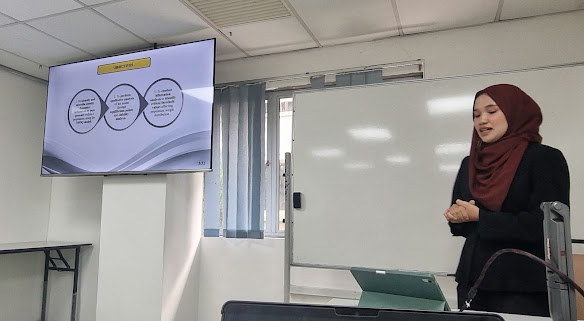Hi,
Today, I want to talk about the four projects my students presented a couple of days ago. Alhamdulillah, everything went perfectly for all of them! They presented their work confidently and handled every question calmly. Most importantly, they truly showcased the diverse applications of mathematics in real life, something I always strive to instil in them.
Such happy faces! They were incredibly nervous before their presentations, but all smiles once they'd crushed it.
Aina kicked off the presentations with her insightful topic: Modelling Public Opinion Propagation in Technological Disasters
Imagine trying to figure out how people react when a disaster happen, like the Petronas underground gas pipeline. She explored a math model, kinda like tracking a cold's spread, but this model is to see how public opinion shifts upon receiving the news. It breaks everyone into four groups: the unaware, the lurkers (quietly watching), the spreaders (sharing info), and the stiflers (who stop caring). She factored in things like disaster severity, government actions, who's to blame, and media vibes to see how these groups are influenced. She dug deep into the math to understand how things settle, how fast info spreads, and if the system stays stable. She even proved theoretically that small changes can totally flip public sentiment, and her model actually works to show how public opinion moves during real crises.
Next up was Afifah, who delved into the Mathematical Relation between Collision Risk and Speed.
Everyone knows how dangerous speeding is right? Have you ever wonder how things work, mathematically? So, she dives into that, using two main mathematical ideas, the Power Model and the Exponential Model, to show how different speeds impact both crash frequency and severity, based on some real data. She crunched the numbers, fitting these models to actual accident data, and then checked how good they were at predicting injuries and fatal crashes. She found that while the Power Model is easy to understand, the Exponential Model actually does a better job of matching what really happens on the road, especially when cars are going really fast. Essentially, picking the right way to analyze speed and using good data is crucial for making our roads safer and managing traffic effectively.
Then Ain captivated the room with her work, resonating with everyone as she discussed on Modelling the Impact of Peer Pressure on Obesity Dynamics.
Now, ever notice how your friends' food habits can totally rub off on you? Like, suddenly everyone's craving that new burger joint? Sounds familiar? 😂Well, her work explored clever math to see how peer pressure can actually make obesity spread like wildfire! She categorized people into normal weight, at-risk, obese, and quitters, finding that even a little nudge from your buddies, especially with fast food, makes a huge difference. In fact, her finding showed that if peer pressure for unhealthy habits hits a certain point, obesity can actually become the norm, uh oh! This just goes to show how powerful your social circle is, highlighting why tackling unhealthy social behaviors early on is super important if we want to keep everyone healthy.
Finally, Nazifa wrapped up the session by presenting her fascinating work on Analyzing the Dynamics of Social Media Addiction: A Mathematical Modelling Approach.
She talked about how your phone always calling you back for just one more scroll that represents social media addiction and how it spreads very perfectly. Her model basically sorted folks into five groups: those susceptible to the digital buzz, the exposed (who've just peeked at a cat video), the fully addicted (send help!), those who've recovered (the lucky ones!), and the quitters (the true heroes who deleted TikTok. Though, let's be real, actually belonging to quitters group in real life feels almost impossible these days!). She proved that even tiny nudges, like a new notification sound or a perfectly timed meme can seriously affect how many people get hooked. She made everyone in the room understands why we can't resist checking our phones, offering clues on how to tackle the digital shackles and get back to, you know, real life. Err, okay girl, okay. I'm busted. 😅
These were the projects! As I mentioned before, while they didn't quite revolutionize any theories, hey, they only had three months! The team successfully applied their math skills to real-world problems. Now they have something tangible to discuss when they leave the nest. You know, even my own family still sometimes wonders what I actually do as a mathematician, so these kinds of projects really help demystify our work. 😂
Total celebration time! We completely ditched talking about work and just chatted about life. I even told them to enjoy single life and not rush into getting hitched, LOL! 😜
That's all for now! Not sure when I'll be back. Constantly adjusting to life seems to leave me speechless these days. See you again soon, hopefully! Bye!






No comments:
Post a Comment